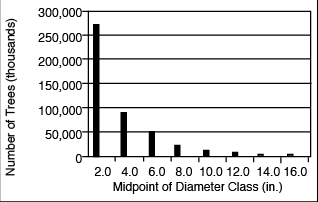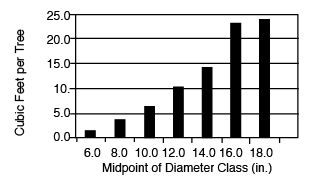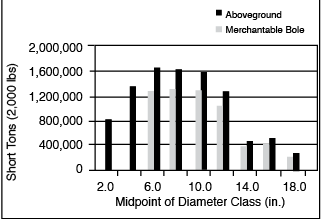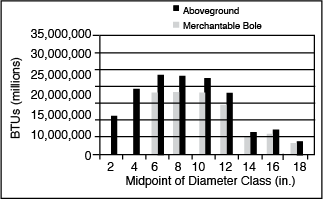The Oklahoma Red Cedar Resource and Its Potential Biomass Energy
Background
Eastern redcedar (Juniperus virginiana L.), commonly referred to as redcedar or cedar, is the most widely distributed conifer in the eastern United States. Redcedar is native to Oklahoma, and the species occurs naturally in all but three or four counties in the state. Significant increases in redcedar infested acreages have occurred during the past 50 to 60 years. It has been estimated that in 1950, redcedar and other junipers covered approximately 1.5 million acres in Oklahoma. By 1985, those species covered approximately 3.5 million acres. The Governor’s Task Force, in 2002, suggested that some 8 million acres of juniper existed in the state. That same Task Force estimated that Oklahoma is losing almost 300,000 acres per year to juniper encroachment.
With the existing economic conditions and with recognition of the problems that result from redcedar encroachment, a number of individuals and organizations are exploring the possibility of utilizing redcedar for bioenergy purposes. This fact sheet summarizes a recent study directed toward the amount of energy potentially available in Oklahoma’s eastern redcedar.
Redcedar volumes and weights were obtained from the U.S. Forest Service Forest Inventory and Analysis (FIA) program. With this protocol, trees are measured in plots established on a grid sample design. In eastern Oklahoma, all plots were re-measured in 2007 and 2008, with 20 percent of the plots measured each year since. Ten percent of central and western Oklahoma counties are being re-measured each year, with approximately 30 percent of the current cycle completed to date. The full cycle for central and western Oklahoma will not be completed until 2017. Thus, a large margin of error currently exists for estimates within that region.
Figure 1. Estimated number of redcedar trees by diameter class in Oklahoma.
Figure 2. Average volume per tree (cubic feet) for Oklahoma redcedar.
Redcedar Volume and Energy Estimates
The state is comprised of some 43,963,000 acres, of which approximately 12,612,000 acres (28.2 percent) are forested. The estimated number of eastern redcedar trees in Oklahoma is 462 million.
The diameter distribution of Oklahoma redcedar trees is presented in Figure 1. The generalized shape of this curve, with a large number of small trees and progressively fewer trees as diameter increases is typical of trees naturally established and grown regardless of species.
Figure 2 demonstrates the relationship between tree size (diameter class) and volume per tree. Although there are few trees in the upper diameter classes, the relatively large volume per tree results in a significant contribution to the overall resource.
The redcedar volume for the state is estimated to be approximately 392,500,000 cubic feet, with about two-thirds of that volume in trees 5.0 to 10.9 inches in diameter.
Total merchantable bole and aboveground dry weights (in tons) for redcedar in Oklahoma are shown in Figure 3.
A total of about 9.6 million tons of aboveground biomass can be found in Oklahoma’s eastern redcedar. Of this total, about 7.4 million tons are classified as being in trees 5.0 inches and larger. Bark comprises 11 percent of the total aboveground biomass. The weight of tree foliage is not available, as that component is not considered a separate category.
For trees 5.0 inches in diameter and larger, about 80 percent of the 7.4 million dry tons of aboveground biomass is in the merchantable bole, with approximately 13 percent in tops and limbs, and 7 percent in stumps.
Figure 3. Total dry weight (tons) in merchantable bole and aboveground biomass for Oklahoma redcedar.
Energy Estimates
Given estimates of volumes and weights for redcedar, the next step is to derive the potential energy value (BTUs) from that material. An energy value of 7,000 BTUs per oven-dry pound was assumed to account for the potential heat losses in the combustion process.
Estimated statewide redcedar energy is shown in Figure 4. For the state’s redcedar resource, 134.7 trillion BTUs exist in aboveground biomass for trees 1.0 inch in diameter and larger. A total of 104.2 trillion BTUs are in the aboveground portion of trees 5.0 inches in diameter and larger.
Figure 4. Estimated total BTUs for Oklahoma redcedar by diameter class.
Commonly Used Terms
Aboveground Biomass – Total oven-dry pounds of the aboveground portion of trees 1.0 inch in diameter and larger.
British Thermal Unit (BTU) – Quantity of heat required to raise the temperature of one pound of water, 1° F. Often used as a measure of energy contained in a fuel.
Diameter Breast Height (DBH) – Tree diameter (in inches) at 4.5 feet above the ground.
Diameter Class – Intervals into which a range of diameters of trees may be divided for use. For example the 6-inch diameter class includes trees from 5.0 to 6.9 inches in diameter (DBH)
Kilowatt – 1,000 watts, a watt is the measure of the rate of energy use at any given moment.
Kilowatt hour (KWH) – Equal to the energy of 1 kilowatt being applied for one hour. 1,000 kilowatts equals one megawatt.
Merchantable Bole Biomass – The oven-dry pounds in the merchantable bole of timber species where diameter is greater than or equal to 5.0 inches in diameter, from a 1-foot stump to a minimum 4-inch top diameter of the central stem or where the central stem breaks into limbs all of which are less than 4.0 inches in diameter.
Merchantable Bole Volume (or simply Volume) – The volume of wood ( cu. ft.) in the central stem of trees greater than or equal to 5.0 inches in diameter, from a 1-foot stump to a minimum 4-inch top diameter or where the central stem breaks into limbs all of which are less than 4.0 inches in diameter
Oven-dry or Bone Dry Ton – 2,000 lbs. of woody material at 0 percent moisture content.
Stump Height – Value given to the height of the stump, assuming tree has been removed. Assumed to be 1 foot above the ground.
Summary
There are approximately 392 million cubic feet in redcedar trees that are 5.0 inches in diameter and larger. Overall, approximately 9.6 million tons of aboveground redcedar biomass exist in Oklahoma. Of this amount, about 7.4 million tons are in trees 5.0 inches in diameter and larger. About 134 trillion BTUs are in aboveground biomass, with some 104 trillion BTUs in the larger diameter category.
While the estimates presented are based upon the best available information, these estimates in no way imply that all the biomass is accessible, available, or economical to harvest, transport, process or utilize for bioenergy purposes. However, this information does suggest that eastern redcedar may hold promise from the standpoint of converting what has become a native, invasive species into a viable energy source.
References
Anon. 2002. A strategy for control and utilization of invasive juniper species in Oklahoma. Final Report of the Redcedar Task Force. Oklahoma Department of Agriculture, Food, and Forestry. Oklahoma City, OK. 54 pages.
Gilman Edward F. and Dennis G. Watson. 1993. Juniperus virginiana – eastern redcedar. University of Florida. Florida Cooperative Extension Service. Fact Sheet ST-327. 4 pages.
Helms, J. A. (editor). 1998. The dictionary of forestry. Society of American Foresters. Bethesda, Maryland. 210 pages.
Ince, Peter J. 1979. How to estimate recoverable heat energy in wood or bark fuels. U.S. Department of Agriculture, Forest Service. General Technical Report FPL-29. Forest Products Laboratory. 7 pages.
Miles, P. D. 2011. Forest Inventory EVALIDator web application version 4.01.01. St. Paul, MN: U.S. Department of Agriculture, Forest Service, Northern Res. Sta. [Available only on internet: http://apps.fs.fed.us/Evalidator/tmattribute.jsp].
McKinley, C.R. 2012. Potential biomass energy available from Oklahoma redcedar. Oklahoma Agricultural Experiment Station. P-1036. Oklahoma State University. 41 pages.
Snook, E.C. 1985. Distribution of eastern redcedar on Oklahoma Rangelands, p. 45-52. In: R.F. Wittwer and D.M. Engle (eds.). Conference Proceedings Eastern Redcedar in Okla. Coop. Ext. Serv. Div. Agric. Okla. State Univ. E-349.
Craig R. McKinley
Natural Resource Ecology and Management Department




